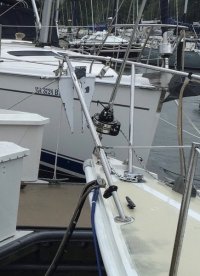Quick background. I'm a relative newbie to sailing anything other than a dinghy. I've had my '77 E27 for about 2 years (coming to my third summer) and anything beyond day sailing has been to sail to other marinas. Starting this spring I plan to do some weekends to spots where I can (and must) anchor out. My questions are about my ground tackle set up. I'm sure I don't know all I should know yet, although, I've been learning and thinking about it a lot. My experience thus far is anchoring in the James for a picnic, or for the shear practice of anchoring.
I have a danforth style anchor pictured. I don't know it's weight, which is pretty irresponsible I realize. It feels to be in the 20 lb range (probably not more). My anchor rode consists of about 20 feet of chain and a 100 feet of anchor rode. I do not have an anchor roller.
My questions are:
It seems risky to me to have my rode cleat hitched to my bow cleat only. What should that set up look like? Do I need some sort of anchor snubber set up, and if so what would that look like?
I'm wondering if a fortress anchor might make life a bit easier if I have to be at the helm (likely) and my wife needs to pull up the anchor. She's much more nervous at the helm. Thoughts on the fortress? (side note: based on my marina survey, the plow anchor is favored all though both types are visible. However, boats with plow anchors tend to be larger AND have rollers to accommodate them. I want to save the cost of figuring out a roller on my boat for a future date).
What other questions should I be asking?
Thanks in advance.
Jay

I have a danforth style anchor pictured. I don't know it's weight, which is pretty irresponsible I realize. It feels to be in the 20 lb range (probably not more). My anchor rode consists of about 20 feet of chain and a 100 feet of anchor rode. I do not have an anchor roller.
My questions are:
It seems risky to me to have my rode cleat hitched to my bow cleat only. What should that set up look like? Do I need some sort of anchor snubber set up, and if so what would that look like?
I'm wondering if a fortress anchor might make life a bit easier if I have to be at the helm (likely) and my wife needs to pull up the anchor. She's much more nervous at the helm. Thoughts on the fortress? (side note: based on my marina survey, the plow anchor is favored all though both types are visible. However, boats with plow anchors tend to be larger AND have rollers to accommodate them. I want to save the cost of figuring out a roller on my boat for a future date).
What other questions should I be asking?
Thanks in advance.
Jay

